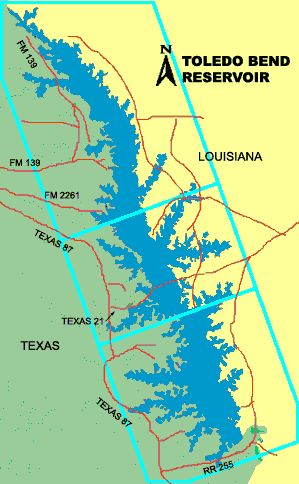Fishing
- Licenses & Regulations
- ShareLunkers
- Fish Identification
- Fish Consumption
- Texas Freshwater Fisheries Center
Water Resources
- Texas Reservoir Levels
- US Army Corps of Engineers
- Texas Water Issues
- Golden Alga
- Aquatic Vegetation
900 CR 218
Brookeland, Texas 75931
(409) 698-9114
Todd Driscoll, Biologist
Local Information
- Jasper Chamber
of Commerce
246 E Milam
Jasper, Texas 75951
(409) 384-2762
Nearby State Parks
Toledo Bend Reservoir
Quick Links: Fishing Regulations | Angling Opportunities | Cover & Structure | Tips & Tactics
Lake Characteristics
Location: On the Sabine River in Shelby,
Sabine and Newton counties, straddling the Texas-Louisiana
state line. The dam is in Newton County approximately 24 miles northeast
of Jasper.
Surface area: 181,600 acres
Maximum depth: 110 feet
Impounded: 1967
Water Conditions
Current Lake Level
Conservation Pool Elevation: 172 ft. msl
Fluctuation: 1-5 feet
Normal Clarity: Clear in middle
and lower lake to slightly turbid in upper region
Consumption Advisory in effect
Reservoir Controlling Authority
Sabine River Authority
Toledo Bend Division
Rt. 1, Box 270
Burkeville, Texas 75932
(409) 565-2273
Aquatic Vegetation
Primarily non-native submersed plants such as hydrilla; a variety of native aquatic plants are also established
Predominant Fish Species
Lake Records
Current
Fishing Report
Stocking History
Latest Survey Report
Lake Maps
General maps can be obtained at the Sabine River Authority of Texas Toledo Bend Division office at the dam (409) 565-2273. Topographical maps are available at local sporting goods stores, marinas, and tackle shops.
Fishing Regulations
Residents of Texas or Louisiana who are properly licensed in their state (or are exempt because of age), or persons who hold valid non-resident fishing licenses issued by either state may fish in any portion of the lakes and rivers forming a common boundary between Louisiana and Texas inland from a line across Sabine Pass between Texas Point and Louisiana Point.
Limits for catfish, crappie, white bass and black basses apply on both the Texas and Louisiana portions of the lake. Harvest regulations for some other species, including alligator gar, may differ between the two states.
- See Texas bag and size limits for Toledo Bend Reservoir.
- For details on Louisiana regulations, visit the Louisiana Department of Wildlife and Fisheries or call (318) 676-7594.
Angling Opportunities
The most popular game fish at Toledo Bend Reservoir is the largemouth bass; an excellent year-round fishery exists. Good year-round crappie and catfish fisheries are also present. Striped bass are maintained by annual stockings because conditions at Toledo Bend usually do not allow a successful natural spawn. Stripers are popular due to their large growth potential and reputation as strong fighters. Bluegill and redear sunfish are present in high numbers and provide excellent fishing, especially for youth or inexperienced anglers.
| Species | Poor | Fair | Good | Excellent |
|---|---|---|---|---|
| Largemouth Bass | ||||
| Catfish | ||||
| Crappie | ||||
| White Bass | ||||
| Striped Bass | ||||
| Sunfish |
Fishing Cover/Structure
Habitat in Toledo Bend Reservoir consists of aquatic vegetation, standing timber, and flooded terrestrial vegetation. Hydrilla is the predominant plant species, although many native plants (coontail, eelgrass, pondweed, lily pads) are also present. In the lower part of the reservoir the water is typically clear; gamefish are usually found around vegetation edges, flats, humps, and creek channels. In the upper third of the reservoir, the abundance of vegetation typically declines. Timber, brush, laydowns, and creek channels provide upper-lake gamefish habitat. At periods of high water, terrestrial bushes and trees provide excellent habitat reservoir-wide. Man-made fish habitat provides additional structure. Anglers may use GPS in conjunction with a fish finder to locate these structures.
Use the Habitat Structure Viewer for an interactive map of fish habitat structures and downloadable GPS coordinates.
Tips & Tactics
Anglers are most successful at catching largemouth bass during the fall, winter, and spring months. Due to cooler water temperatures, fish are active for longer periods of the day and are typically found in shallow water. A variety of baits and techniques will work during these times. When fish are active, crankbaits and spinnerbaits are usually the preferred choice. During the hot summer, the bite slows and fish activity is usually concentrated during early morning, late evening, and at night. Poppers, propeller baits, stickbaits, buzzbaits, and flukes are good topwater choices during low light conditions. As the sun rises, most bass concentrate in or around vegetation edges, or seek refuge on deep ledges and creek channels. During this time, plastic worms and jigs are the preferred baits.
Crappie fishing is good year-round with jigs and minnows. However, fishing usually peaks during the spring spawn, when anglers target shallow areas around vegetation. During other times of the year, fish are typically concentrated in deeper water around brush piles and creek channels. Anglers catch channel, blue, and flathead catfish throughout the reservoir. Channel catfish can be caught with stinkbait in areas baited with soured grain. Trotliners catch both blues and channels on cut bait, while flathead catfish prefer live bait.
The white bass fishery is essentially limited to the early spring during the spawning run above the reservoir. Anglers have good success with small spinners, jigs, jigging spoons, and small crankbaits. During the summer and fall, watch for schooling striped bass on main lake points, humps, and flats adjoining river channels. Schooling stripers can be caught on topwaters, rattle traps, and spoons. Toledo Bend has a reputation for producing lots of huge sunfish. Most of the bigger sunfish, especially bluegill and redear sunfish, are caught during the late spring or summer when fish are on spawning beds. Small jigs, spinners, and crickets are good choices.
